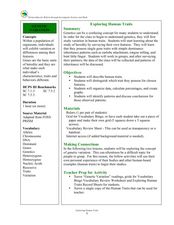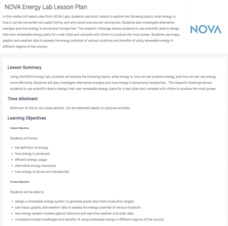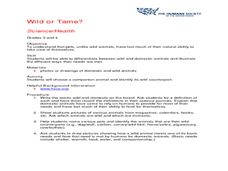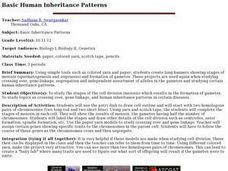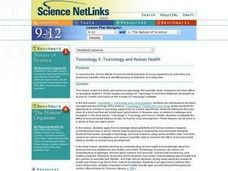Curated OER
Writing Letters for Human Rights
Students draft and edit a letter regarding human rights. They work in groups to select a cause, follow basic letter writing guidelines and draft a persuasive letter expressing their concerns. Students can also send the letters to a...
Curated OER
Human Traces
Students create and construct human skeletons by rubbing casts of bone impressions on paper, and then label most important components of human skeleton.
Curated OER
Exploring Human Traits
Students explore human behavior by participating in a class science game. In this human characteristics instructional activity, students identify different human traits that are passed down by each generation and the purpose each of them...
Curated OER
Physical and Human Geography Review Worksheet and Study Guide
In this geography skills activity, students respond to 30 short answer questions pertaining to physical and human geography.
Curated OER
Determining Needs Versus Wants
Students discriminate between a need and a want in home buying. They write a detailed description of their dream home. Finally they categorize each of their listed home features as a need or a want.
Curated OER
Human Body Basics
In this human body worksheet, students are given clues to find hidden words in boxes. Topics include the human body systems, the components of living things and the building blocks of life.
Curated OER
Wolf Habitat
Students identify their own basic needs for food, water, shelter and space in a suitable arrangement. They generalize that wolves and people have similar basic needs.
PBS
NOVA Energy Lab Lesson Plan
Can our energy resources keep up with our ever-growing population? Science scholars learn the basics of energy and Earth's energy resources during an electrifying lesson. The resource combines video clips and an engineering design...
Curated OER
Lesson Plan on Homeless Children
Students research reasons as to why children end up living on the streets. This instructional activity examines reasons as to what happens to parents and adult caregivers so that they are no longer able to provide basic needs for these...
Curated OER
PEOPLE OF THE STONE AGE
Sixth graders summarize how early people interacted to meet basic human needs. They observe how increased numbers of people and the search for food led to migration. Students analyze how the interactions among people led to the...
Curated OER
Survival: The Human Body in Extreme Environments
Students create a list of signs the human body gives during threatening weather conditions. They investigate the causes and conditions of dehydration, overheating, and hypothermia.
Curated OER
Wild or Tame?
Students explore wild and domestic animals. In this animal activity, students define wild and domestic. Students are shown pictures of animals and choose if they are wild or domestic. Students name pets and name their wild counterpart....
Curated OER
Living and Non-Living
Students discover the basic needs of life. In this science lesson plan, students explore how all living things need air, water, food and shelter
Michigan Sea Grant
Fish Habitat and Humans
Strict habitat requirements are needed for the survival of fish populations and fish variety in the Great Lakes. Young scientists become experts in the basic needs of fish and understand how survival necessities can vary with different...
Curated OER
Education: Passing Enough Knowledge to Survive to the Next Generation
Students compare and contrast the knowledge requirements for human and animal children. They identify the consequences of an animal if it is unprepared for the given environment. They discover the importance of education as well.
Curated OER
Managing Wildlife
Students explore the relationship between wildlife and humans in northern New England. They also brainstorm ideas on why they think some species are greater in population than others in a given area.
Curated OER
You Need How Much Food When? Where?
Ninth graders explore how human activities shape the earth's surface. In this awareness lesson, 9th graders create pictographs showing the relations of food, people, land, and resources. Students complete worksheet.
MOST
What Are Cells?
What's in a cell, anyway? Kids read informational text on what makes up both animal and plant cells, including a page of vocabulary terms they will need to be familiar with (cytoplasm, ribosomes, vacuoles, etc.). Full-color images make...
Curated OER
Basic Human Inheritance Patterns
Students study the stages of the cell division (meiosis) which results in the formation of gametes and study topics as crossing over, gene linkage, and human inheritance patterns in certain diseases.
Curated OER
Needs of Living Things
Students discuss and explore the needs of living things. They choose to create a slide show with captions, create a web showing the needs of one Organism using KidPix. or make picture book by hand or using Microsoft Publisher.
Curated OER
Toxicology And Human Health
Students examine the clinical effects of environmental toxicants on living organisms by collecting and analyzing scientific data and identifying ways of detection and diagnosis.
Curated OER
GET UP, STAND UP: Fighting for Rights Around the World
Students explore basic human rights as they explore music by black artists. In this human rights lesson, students examine music as a cultural reflection of the justice issues. Students analyze Jamaican roots reggae of the 70s, American...
Curated OER
MuscleMania
Students learn three different types of muscles. By building a model of the arm, they learn its basic anatomy and how muscles function in relationship to bones. They perform an experiment on the relationship between muscle size and...
Curated OER
Where is Agriculture?
Students study agriculture. In this agriculture lesson, students investigate how agriculture helps to meet a family's needs. Students identify things in their home that began as agriculture.




